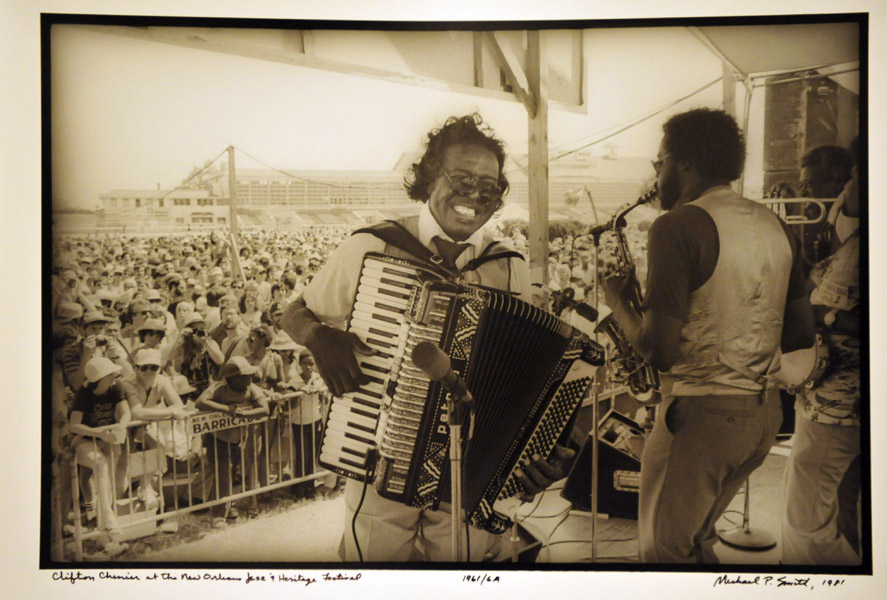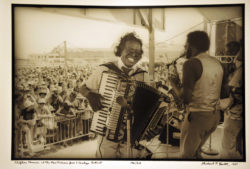New Orleans Jazz & Heritage Festival
Founded in 1970, the New Orleans Jazz & Heritage Festival, known as Jazz Fest, draws hundreds of thousands of visitors a year to experience the music, cuisine, and cultural heritage of Louisiana.

The Historic New Orleans Collection.
Black-and-white reproduction of a photograph of Clifton Chenier at Jazz Fest, taken by Michael P. Smith in 1981.
Each year, the New Orleans Jazz & Heritage Festival, commonly known as Jazz Fest, draws hundreds of thousands of visitors to experience the music, cuisine, and cultural heritage of New Orleans and Louisiana. Founded in 1970, the event began modestly, drawing a mere 350 attendees, but it has grown into one of the largest festivals in the United States—and, in the process, a major economic boon for New Orleans—with a record attendance of 650,000 visitors over the course of seven days in 2001. According to its mission statement, “The New Orleans Jazz & Heritage Festival and Foundation, Inc., promotes, preserves, perpetuates, and encourages the music, culture, and heritage of communities in Louisiana through festivals, programs, and other cultural, educational, civic, and economic activities.”
Founding and Early Years
Jazz Fest was founded by jazz pianist and entrepreneur George Wein, who has been credited by jazz historian Leonard Feather as starting “the festival era” with the creation of the Newport Jazz Festival in 1954. In the early 1960s New Orleans civic leaders approached Wein about producing a jazz festival in the city with the aim of boosting tourism. In 1969 Wein established Festival Productions, the company that remains the production arm of Jazz Fest and hundreds of other music events worldwide. Wein and his attorney and business partner, Elliott Hoffman, hired Arthur Q. “Quint” Davis Jr. and Allison Miner to book musicians for the inaugural festival. These two music enthusiasts had worked for historian Richard “Dick” Allen at the William R. Hogan Archive of New Orleans Jazz at Tulane University. Radio disc jockey and Minit Records co-founder Larry McKinley was also an early advisor to the festival; today, recordings of his voice greet and offer information to attendees entering the festival.
The first Jazz Fest took place between April 22 and 26, 1970, in Congo Square, then known as Beauregard Square, in Louis Armstrong Park. Attendees only numbered about 350—fewer than half of the total number of musicians and staff it took to present the event. Headliners included Duke Ellington, Pete Fountain, Al Hirt, Clifton Chenier, The Olympia Brass Band, and Mardi Gras Indians who paraded through the grounds every day. Louisiana native Mahalia Jackson, scheduled to perform at the nearby Municipal Auditorium, thrilled the first audience with an impromptu “Just a Closer Walk with Thee” during a second line parade with the Eureka Brass Band.
By 1972 the festival had outgrown the park and moved—with the help of a $25,000 line of credit signed by architect Arthur Q. Davis Sr., Quint’s father—to the infield area of the New Orleans Fair Grounds Race Course. Jazz Fest continues to take place at the Fair Grounds each year on the last weekend of April and the first weekend of May. Between 1972 and 1976, the festival grew to encompass two three-day (Friday through Sunday) weekends. During the 1980s, evening concerts in theaters and nightclubs were developed for the days between the two weekends. In 1991 the festival added an additional Thursday to its second weekend.
Stages, Crafts, and Food
Jazz Fest’s enduring appeal is due in part to the wide variety of music it offers on a dozen stages. The large Acura and Gentilly stages that anchor both ends of the Fair Grounds host headliners, including local acts such as the Neville Brothers, Fats Domino, and Dr. John along with pop stars Bruce Springsteen, Willie Nelson, Bonnie Raitt, Jimmy Buffett, Stevie Wonder, and Paul Simon, among others. The Congo Square stage presents world music, hip-hop, contemporary rhythm and blues (R&B), and soul. The Fais Do-Do stage features Cajun, zydeco, and folk music. Three tents are dedicated to gospel, blues, and contemporary jazz. The Economy Hall Tent is home to traditional jazz, while the Jazz & Heritage stage hosts Mardi Gras Indians and local brass bands. The Kids Tent and adjacent children’s activity area provide entertainment for youngsters. The Lagniappe Stage, inside the grandstand’s paddock area, presents a variety of acts. In addition, Mardi Gras Indian tribes and brass bands, followed by second-lining social aid and pleasure clubs, parade through the Fair Grounds at regular intervals each day of the festival.
Another draw is the festival’s arts and crafts booths, which feature local and national artisans as well as a wide range of Louisiana food vendors, all of whom have been an integral portion of Jazz Fest since its founding. Such food items as Crawfish Monica and alligator sauce piquante have become synonymous with the fest. Other popular Louisiana dishes include stuffed bread, prepared by the Creole Lunch House based in Lafayette, and pheasant, quail, and andouille gumbo from Prejean’s restaurant, also in Lafayette. The New Orleans–based Vaucresson Sausage Company, with its hot sausage po-boy, is the only vendor to have participated at every Jazz Fest since 1970.
In the Louisiana Folklife Village, artisans demonstrate crafts and customs, including ironwork, woodwork, leatherwork, and Native American traditions. During Jazz Fest, artists, craftspeople, and retailers display their wares at three major vending areas on the Fair Grounds: the African Marketplace, Contemporary Crafts, and the Louisiana Marketplace. The festival poster series was launched in 1975, featuring paintings of iconic Louisiana musicians by major artists; the annual, limited-edition poster has become one of the festival’s most popular collectibles. Inside the racetrack’s grandstand, selections from local museums—such as the Backstreet Cultural Museum and the Ogden Museum of Southern Art, as well as curated collections of Louisiana photography—are displayed. The grandstand also houses the Allison Miner Music Heritage Stage (named in honor of the founding employee who died in 1995), which features interviews with musicians who are performing at the fest, and the Food Heritage Stage, where chefs perform cooking demonstrations.
Though Jazz Fest was originally conceived to showcase Louisiana talent, organizers throughout the 1990s began to book increasingly mainstream acts from outside the state as headliners, explaining that the high-profile entertainers drew more visitors and, consequently, increased the event’s profits. Objections from longtime Jazz Fest fans were answered with the explanation that artists such as Bob Dylan, the Allman Brothers, and Joni Mitchell reflected the “heritage” in the Jazz & Heritage Festival’s title. In 2001, on the day that both the Dave Matthews Band and Mystikal performed, festival attendance hit its single-day record of 161,000. In 2004, after that year’s festival suffered a $900,000 loss—largely due to rain-soaked days—the Jazz & Heritage Foundation board put production of the event out to bid but eventually chose to retain Festival Productions. After securing production of the festival for another five years (with an option to renew for another ten), Festival Productions partnered with AEG Live, a massive international production company that had bid against them for the production contract. Since the partnership with AEG, Jazz Fest has seen an increasing number of mainstream music headliners, including Cyndi Lauper, Pearl Jam, and Jon Bon Jovi.
Jazz & Heritage Foundation
The Jazz & Heritage Foundation was founded in 1970 as the nonprofit arm that owns and oversees the festival. Throughout the year, the foundation organizes educational and cultural programming, including the Don Jamison Heritage School of Music, a free program for students between the ages of eleven and seventeen who learn jazz fundamentals from professional New Orleans musicians. Other projects include the Tom Dent–Congo Square Series of lectures and symposia dedicated to Louisiana culture, and the Jazz & Heritage Foundation Archive, which preserves recordings of festival performances, interviews with artists, film footage, the foundation’s business records, and other artifacts dating back to the inception of the fest. The foundation’s best-known venture is WWOZ, a radio station whose stated mission is “bringing New Orleans music to the universe.”
After Hurricane Katrina, the foundation added several smaller, free festivals to its calendar—the Crescent City Blues & BBQ Fest, Fiesta Latina, the Congo Square Rhythm Festival, the Louisiana Cajun–Zydeco Festival, and the Tremé Creole Gumbo Festival—to expand the city’s cultural economy by creating opportunities for entertainers, food vendors, and craftspeople. In 2008 the Foundation debuted Sync Up, a networking event and conference that connects Louisiana musicians with media buyers and music supervisors from film and television.
After levee failures inundated the Fair Grounds during Hurricane Katrina, the 2006 festival was in jeopardy. The Shell Exploration Company stepped forward with sponsorship and allowed the event to go on. With the oil company’s continued support, the festival’s official name is now The New Orleans Jazz & Heritage Festival Presented by Shell.
